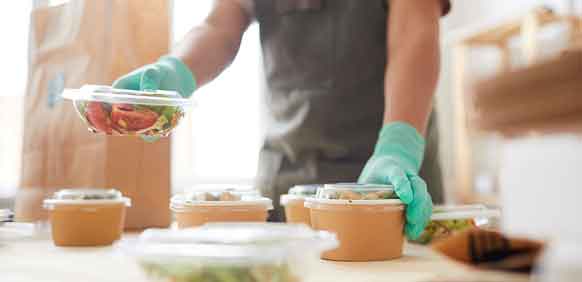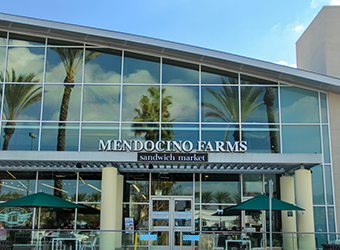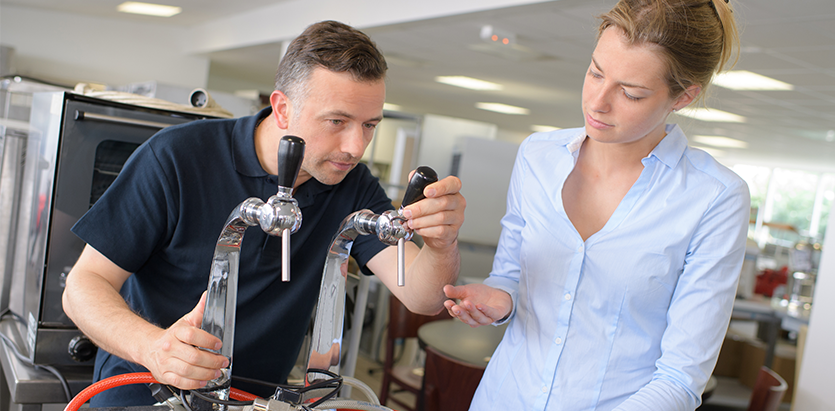Meredith Sandland and Carl Orsbourn, food industry leaders, are the co-authors of the new book Delivering the Digital Restaurant: Your Roadmap to the Future of Food.
Focusing on the rise of off-premise business and digital interfaces in the restaurant industry, their insights will resonate with facilities managers and any restaurateur looking to navigate the new normal.
How is automation and technology transforming facilities management and off-premise businesses? Here are some of the key takeaways from the book, available now at www.deliveringthedigitalrestaurant.com (use ECO25 for Ecotrack’s exclusive 25% discount).
Focusing on customer-centric & off-premise business
According to Delivering, the COVID-19 pandemic only accelerated disruptive trends that were already in motion. Restaurants now need to “shift how they think, behave, and invest to survive and thrive” to keep up with today’s consumer.
Consumers are demanding from restaurants what they’ve already been demanding from retail: quality and convenience, when and where they want it. Restaurants that can provide good quality food, with a frictionless, on-demand interaction, will be able to capitalize on new opportunities.
While some restaurants want to “return to normal,” Delivering argues that the baseline has fundamentally changed and is requiring new investments in technology. “The change in the consumer is creating the reason for technological investments to be made, not the other way around,” said co-author Meredith Sandland.
“The customer is now the center of your technological universe,” added Carl Orsbourn, co-author. “You need to make your decisions based around how to improve the consumer journey and your own engagement with the consumer. This means using data.”

Transforming the industry because “digital is not optional”
According to Delivering, “running a successful restaurant in the 21st century requires not just great food and great service—it also demands an understanding and application of technology.”
Sandland admitted the challenge of incorporating technology into business is difficult. She gave the example of a small chain restaurateur reporting that he received at least 10 emails or phone calls a day from companies trying to sell software and tech services, and he struggled to find the one that matched his restaurant needs. “The number of new technology solutions out there is so high, it can be completely overwhelming,” she acknowledged.
But while it may be a challenge, Sandland strongly advocated that technology offers a better way to operate a restaurant.
As the former Chief Development Officer for Taco Bell, she has deep experience with facility management. To streamline the time-consuming nature of maintaining and repairing equipment, the maintenance team used custom in-house software years before such things were widely available. These in-house solutions “allowed us to add efficiencies that other, smaller restaurant chains couldn’t access” while tracking service tickets and preventative maintenance.
“Before, it took a giant company like Yum! Brands [parent company of Taco Bell], with a huge balance sheet, to build these incredible technologies that only they could have. They needed a scale of all their restaurants to really have it make sense,” Sandland said.
“The new ‘SaaS-ification’ of technology is remarkable,” she continued. As software as a service (SaaS) companies grow offerings for technology and automation, smaller restaurant companies now have access to the same innovative software that can transform operations.
“Now, anyone can get these things for a monthly fee. I think it levels the playing field between the really big restaurant companies and the smaller ones,” she added.
Automating as much as possible
Now that efficient technology and software is available to restaurants, Sandland and Orsbourn advocate for facilities to take advantage of it as much as possible, particularly through automation.
Sandland explained that restaurant managers are responsible for a dizzying array of tasks, from HR to facilities to food and customer service. “If you can automate with software as much as possible, so that the heavy lifting is being done in a replicable and scalable way—I think it's critical for an operation to run effectively,” she explained.
Investing in automation can benefit restaurants particularly as labor costs continue to rise. Adding in new layers like remote management, or automation that increases speed of off-premise order aggregation and fulfillment, allows restaurants to cope with new challenges.
While it can be time-consuming at first, Orsbourn recommended following your own “technology road map” to understand what tech you need, when. How you implement automation, he said, depends on “where you are in your journey towards digital maturity”. The co-authors recommended starting by examining where there may be a cost problem, top line issue, or a bottleneck in tasks.

Leveraging scale in off-premise opportunities like ghost kitchens
Delivering the Digital Restaurant also discusses the rise of ghost kitchens, restaurants that sell food without a front-of-house brand presence. These facilities may house multiple concepts within the same space, providing new efficiencies for utilities, labor, supply chain, and building costs.
Opportunities of scale can provide enormous benefits for facility management, said the co-authors. For example, for facilities that struggle to get out of a loop of reactive maintenance, ghost kitchens provide an opportunity to get ahead of preventative maintenance. With a density of restaurants in one location, said Sandland, “you can set up relationships with vendors to come in and do preventative maintenance in a way that's much more scalable for the vendor—and potentially get a discount on that as a result.”
The density also provides opportunities of scale for technology solutions as well. With the consumer demand for speed in off-premise sales and delivery, “that sets up a whole world of automation that can come in and make that process more efficient” in ways that might not apply to a smaller restaurant, added Sandland.
Increasing efficiency in facility management with new technology solutions
Facilities managers are at the forefront of using technology in a customer-centric, off-premise world. Sandland and Orsbourn highlighted multiple areas for facilities management professionals to focus on.
For example, Sandland explained that as consumers come back to dine-in, being up-to-date with repairs for items that consumers can see, touch, and feel is critical to a positive customer journey. While this may not have been a priority for facilities in the past year of minimal in-house sales, now, said Sandland, “if customers see things in front-of-house that are broken, they start to wonder what’s going on in the back-of-house.”
Orsbourn highlighted the need to prioritize building trust with consumers. The “open kitchen” model had been popularized in recent years, so customers could see their food being prepared. Now, in a world of food delivery and ghost kitchens, “all of that is hidden away,” said Orsbourn. The possibility of eventual trust or disconnection issues makes maintaining facilities and any customer-facing facilities more critical than ever.
Technology is also helpful for “monitoring kitchen usage as efficiently as possible”, said the co-authors.
Orsbourn shared that as “virtual brands” in ghost kitchens start to share spaces, “slightly movable pieces of equipment can help virtual brands in a more effective way” through an adjustable kitchen configuration. “I think there will be ways in which facilities managers are going to have to be able to understand the modularity of the kitchen to accommodate that,” he added.
Orsbourn also highlighted the major development of these off-premise kitchens: while restaurant revenue used to be limited by number of tables and turn times, for a model like a ghost kitchen, the limiting factor is actually the maximum throughput capacity of a kitchen.
“If I did have an infinite amount of tables out there, how many dishes could I truly push out through this kitchen? And what would I need to do to make that happen?” he said. Facility management is primed to take center stage as restaurants consider investing more in remodeling back-of-house instead of front-of-house.
Sandland agreed, adding, “I think there will be a lot more attention turned to the back of the house. How is it set up? What equipment is in it? What needs to be replaced? What should be more efficient? What should be more automated? The facilities management team typically gets to implement those decisions.”
Conclusion
As these developments take over the industry, it is clear that automation and other smart solutions in facilities management are more important than ever.
Interested in learning more takeaways from Delivering the Digital Restaurant: Your Roadmap to the Future of Food? Grab a copy of the book to learn more from Carl Orsbourn and Meredith Sandland’s industry insights (go to www.deliveringthedigitalrestaurant.com and use code ECO25 for a 25% discount and free shipping).
And if you are thinking about how facility management software can help your facility or ghost kitchen thrive in this new technology-driven world, consider exploring a facility management software solution such as Ecotrak. Using a Computerized Maintenance Management Systems (CMMS) can help you track equipment in ghost kitchens and other off-premise businesses to thrive in today’s new restaurant industry.



